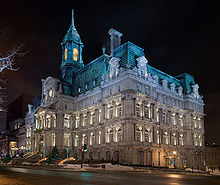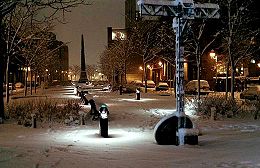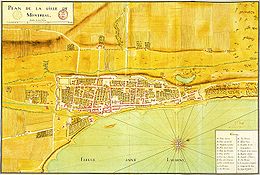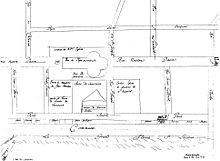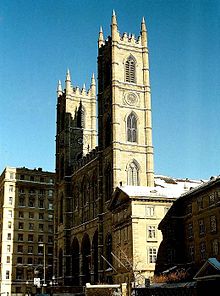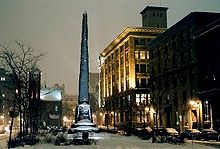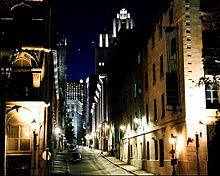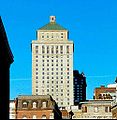- Old Montreal
-
Old Montreal (French: Vieux-Montréal) is the oldest area in the city of Montreal, Quebec, Canada, dating back to New France. Located in the borough of Ville-Marie, the area is bordered on the west by McGill St., on the north by Ruelle des Fortifications, on the east by Berri St. and on the south by the Saint Lawrence River. Following recent amendments, the district has been expanded slightly to include the rue des Soeurs Grises in the west, Saint Antoine St. in the north and Saint Hubert Street in the east. It also includes the Old Port of Montreal. Most of Old Montreal was declared an historic district in 1964 by the Ministère des Affaires culturelles du Québec.
Contents
History
Origins
In 1605 Samuel de Champlain set up a fur trading post at Place Royale , at the confluence of the Saint Laurence River and the long-vanished Petite Rivière St-Pierre, adjacent to present-day Place D'Youville and the Pointe-à-Callière Museum. However, the local Iroquois successfully defended their land and the post was abandoned.
The original site of Montreal in 1642, then known as Ville-Marie, is precisely known. This is the Pointe-à-Callière, a piece of land at the confluence of the St. Lawrence River and Little River. The founder, Paul Chomedey de Maisonneuve, built a fort in 1643 called Société Notre-Dame de Montréal for the conversion of the Indians in New France. The company was created by the Sulpicians Jean-Jacques Olier and Jérôme Le Royer (Sieur de La Dauversière) in 1642. The Société acquired sovreignty over the island of Montreal and brought the first settlers to house, feed, educate and care for the Amerindians. Because of flooding, they had to cross to the other side of Little River on the north shore where the Soeurs hospitalières (Hospital Sisters) of Montreal (under the direction of Jeanne Mance) built and operated the first hospital (the Hôtel-Dieu de Montréal).
French colony
After the bankruptcy of the Société Notre-Dame, the Sulpicians (who arrived in 1657) became in 1663 the Seigneurs of Montreal as Louis XIV took personal control over the colony. The new system gave them the island of Montreal, with the obligation to live there and ensure its development by cultivating the land. In 1665 the king sent 1,200 men, the Régiment de Carignan-Salières. The Sulpicians organised seigneuries at the centre of the island. François Dollier Casson established the first grid of streets in the colony, from existing trails. These early streets included the Rue Notre-Dame, the Rue Saint-Paul and Rue Saint-Jacques; the original grid is still visible today. Among buildings of the era are the Hôtel-Dieu de Montréal, the Saint-Sulpice Old Seminary and Notre Dame Church (replaced later by the Notre-Dame Basilica).
In the early 18th century, the name of Montreal (which originally referred to the mountain "Mont-Royale") gradually replaced that of Ville-Marie. It had become a typical French colony, in which the initial dream to combine the settlers and Native Americans had vanished. The arrival in 1657 of Marguerite Bourgeoys (who founded the Congregation Notre-Dame), and the arrival of the Jesuits and Recollets in 1692, helped to ensure the Catholic character of the settlement.
The original fortifications of Montreal, erected in 1717 by Gaspard Chaussegros de Léry, formed the boundaries of Montreal at the time. The fortifications were constructed to secure the settlement from a British invasion and to allow future expansion inside the walls. Though the walls may have provided security from invasion, they led to a different problem; a large concentration of wooden houses (with fireplaces) was the cause of many devastating fires. In 1721, Montreal received a royal order from France to ban wood construction; buildings were to be constructed using stone, but the ban was never fully respected.
British rule
New France became a British colony in 1763 after the French and Indian War. British rule would radically change the face of Old Montreal. Until the late 18th century the impact was not visible, as construction methods inherited from the French regime continued. However, distrust of the British authorities of the Catholic clergy caused the departure of several from Old Montreal. Another factor changed the appearance of Old Montreal: fires. Wood construction and an increased population density due to the construction of fortifications caused many fires, and conflagrations have reconfigured Old Montreal. The fires of 1765 and 1768 destroyed nearly half the buildings in the old city. In May 1765, fire destroyed about 110 houses before destroying the old Hôtel de Callière and the former General Hospital. In April 1768, 88 houses between rue Saint-Jean-Baptiste and Hotel Vaudreuil were burned, including the Congregation Notre-Dame convent. In following years, the city was to be rebuilt even more densely.
On 6 June 1803 a massive fire destroyed the prison, the church and the dependencies of Jesuits, a dozen houses and the former residence of the Marquis de Vaudreuil. Two speculators bought the field of Vaudreuil, offered one-third to the city and divided the rest into seven lots of their own. The space granted to the city became the new market square, called Marché Neuf (New Market) before assuming its present name of Place Jacques-Cartier in 1845. The space occupied by the church of the Jesuits became the Place Vauquelin, and Montreal City Hall arose from the old Jesuit gardens in 1873.
In 1821 a fire destroyed the Mansion House, a luxurious hotel dating from 1815 which had housed the first public library in Montreal (with over 7,000 volumes). It was replaced by the British-American Hotel, with the city's first permanent theatre (the Royal Theatre, which was visited by Charles Dickens). The hotel burned in 1833, and was rebuilt in 1845 at the Bonsecours Market. In 1849, a riot caused a fire with political consequences when, protesting against a law, a Tory crowd burned down the Parliament building in the old Marché Saint-Anne on Place d'Youville. Following this incident Parliament moved to the new capital, Ottawa. Ironically, the site of the Parliament fire housed Montreal's first fire station in 1903; the building still exists as the Centre d’histoire de Montréal.
Colonial authorities decided upon the first radical transformation of the area in 1804, with the destruction of the fortifications surrounding the heart of Montreal. Completed in 1815, this enlarged the perimeter of Old Montreal and improved access to suburban communities. Confinement in a fortified and very dense area caused the departure of the richer merchants for the perimeter, where it was possible to build luxury residences on large lots.
The 19th century witnessed the emergence of a bourgeoisie of merchants very different from the aristocracy of the old French regime. The growing activity of the port changed the urban landscape. Old Montreal became less residential, as the rich merchants built extravagant homes closer to Mont Royal. Anglophone influence became particularly strong in the areas of banking and finance. St. James Street became the financial centre of Montreal, with large banks such as the Bank of Montreal and the Royal Bank, insurance companies and the stock exchange.
Most of the financial buildings on St. James Street were designed by Anglo-Saxon architects in neoclassical style and built of stone.[citation needed] The same is true for institutional buildings such as the Old Court House, the Customs House, the Bonsecours Market and even the Notre-Dame Basilica (whose façade is the work of an Irish Protestant from New York, James O'Donnell). The only notable exception is the Montreal City Hall, which was inspired by the Hotel de Ville de Rennes. The character of the Victorian style of the late-19th-century buildings was a significant change from the stone masonry used during French rule, and affected the appearance of Old Montreal.
Decline, preservation and renewal
During the early 20th century the momentum of the district continued to grow, evidenced by construction of prestigious buildings such as the Aldred Building (1929–1931), La Sauvegarde Building (1913) or the first Stock Exchange (1903–1904). Port activities, the financial sector, justice and the municipal government helped maintain activity until the Great Depression began in 1929. The relocation of port facilities further east deprived Old Montreal of many companies related to the maritime trade, leaving many abandoned warehouses and commercial buildings. The downtown-area relocation several blocks north and the nearly-complete absence of residents (there were only a few hundred in 1950) had the effect of emptying the district at the close of business. At that time, the lack of nightlife gave the district a reputation for danger at night.
Old Montreal increasingly found itself changing to accommodate the automobile. Several prestigious locations, such as the Place d'Armes, the Place d'Youville and Place Jacques-Cartier, were snarled with traffic in the mid-20th century. For municipal authorities unaware of its potential heritage value, Old Montreal was an anomaly. City planners considered wider streets, which would have meant razing many older buildings. A proposed elevated highway along the river over the rue de la Commune spurred a movement to preserve the district. Dutch-born architect and urban planner Daniel van Ginkel played a major role in saving the district from destruction during the early 1960s. As assistant director of the city of Montreal's newly-formed planning department, he persuaded authorities to abandon plans for an expressway that would have cut through the old city.[1] In 1964, most of Old Montreal was classified as an historic district; despite this, the Quebec government razed several 19th-century buildings to build a new courthouse.
Revitalization of the district involves the inventory, upgrading and renovation of abandoned buildings, which are converted into offices or residential condominiums; the process is often expensive. In addition to the return of a residential base, the area is again attractive to the hotel industry. While in the 19th century all major hotels were in Old Montreal, by 1980 there were none. In 2009 there were about 20, mostly in restored older buildings. A steady stream of tourists and the presence of new residents encourage nightlife and entertainment. In addition, municipal authorities have invested large sums to renew the area's infrastructure. The Place Jacques-Cartier and part of the Place d'Youville have been redesigned, and a restoration of the Place d'Armes is in progress. A lighting plane was also developed to highlight the different façade styles. There is now a consensus that the historical legacy of Old Montreal is its major asset. Aided by redevelopment, it is now the leading tourist destination in Montreal.
Features
Old Montreal is a major tourist attraction;[2] with some of its buildings dating to the 17th century, it is one of the oldest urban areas in North America. In the eastern part of the old city (near Place Jacques-Cartier) are found Montreal City Hall, Bonsecours Market and Notre-Dame-de-Bon-Secours Chapel, as well as preserved colonial mansions such as the Château Ramezay and the Sir George-Étienne Cartier National Historic Site of Canada. Further west, Place d'Armes is dominated by Notre-Dame Basilica on its southern side, accompanied by the Saint-Sulpice Seminary (the oldest extant building in Montreal). The other sides of the square are devoted to commerce; to the north is the former Bank of Montreal Head Office and to the west, the Aldred Building and the 1888 New York Life Building, the oldest skyscraper in Canada. The rest of Saint Jacques Street is lined with old bank buildings (like the Old Royal Bank Building) from its heyday as Canada's financial centre. The southwest of the old city contains important archeological remains of Montreal's first settlement (around Place d'Youville and Place Royale) in the Pointe-à-Callière museum.
Architecture and cobbled streets in Old Montreal have been maintained or restored to keep the look of the city in its earliest days as a settlement, and horse-drawn calèches help maintain that image. The old town's riverbank is taken up by the Old Port (Vieux-Port), whose maritime facilities are surrounded with recreational space and a variety of museums and attractions.
Champ de Mars
Champ de Mars is a large public space located between Montreal City Hall and the Ville-Marie Expressway. It offers a view of downtown Montreal and Chinatown. It is notable due to its location and its archaeological remains. The two parallel lines of stone are one of the few spots in present-day Montreal where you can still see physical evidence of the fortified settlement from colonial times.
Transportation
Old Montreal is accessible from downtown via the Underground City and is served by several STM bus routes and the Champ-de-Mars, Place-d'Armes, and Square-Victoria metro stations. Ferries to the south shore city of Longueuil are available during the summer, as are a network of bicycle paths.
Gallery
-
New York Life Building, the oldest skyscraper in Canada, Place d'Armes
-
View to Place d'Armes
-
Dome of the Bonsecours Market
-
City Hall and Old Court House
Sources
- Lauzon, Gilles; Forget, Madeleine (2004). Old Montreal: History through Heritage. Montréal: Les Publications du Qhébec. p. 293. ISBN 2-551-19654-X.
- McLean, Eric (2004). The Living Past of Montreal. Montréal: McGill University Press. p. 64.
- Pinard, Guy (1987-1995). Montréal, son histoire, son architecture. (6 vol) Montréal: Éditions La Presse, Méridien. p. 1800 pages. ISBN 2-89415-039-3.
References
- ^ Martin, Sandra (July 23, 2009). "Sandy van Ginkel rescued Old Montreal from freeway developers". Globe and Mail. http://www.theglobeandmail.com/news/national/sandy-van-ginkel-rescued-old-montreal-from-freeway-developers/article1229337/. Retrieved 2009-07-24.
- ^ http://www.arvm.ca/le-v-m-dans-les-medias/communiques/364-quais-du-vieux-port-de-montreal-bilan-positif-pour-lete-2009.htm
External links
- Old Montreal — official site
- Architecture of Old Montréal
- Photo Gallery of Old Montréal
- Picture of Old Montréal on Images Montréal
- Condo Buildings in Old Montreal - an illustrated list
- Marguerite Bourgeoys Museum in Old Montreal
History of Montreal Topics Hochelaga · Fort Ville-Marie · Notre-Dame de Montréal · Governor of Montreal · Hôtel-Dieu · Saint-Sulpice Seminary · Battle of Long Sault · Old Montreal · Great Peace of Montreal · Citadel · Grey Nuns · 1732 earthquake · Capitulation of Montreal · American occupation · North West Company · Bank of Montreal · Lachine Canal · List of Mayors · Burning of the Parliament · Gavazzi Riots · Victoria Bridge · Golden Square Mile · Oldest buildings · Ouimetoscope · St. Lawrence Seaway · Expo 67 · Sir George Williams Computer Riot · Murray-Hill riot · October Crisis · Montreal Urban Community · 1976 Summer Olympics · Overdale · Montreal Protocol · École Polytechnique massacre · Montreal merger · Dawson College shooting · National Historic Sites in Montreal
Timeline Pre-European period • 16th Century • 1600s • 1610s • 1620s • 1630s • 1640s • 1650s • 1660s • 1670s • 1680s • 1690s • 1700s • 1710s • 1720s • 1730s • 1740s • 1750s • 1760s • 1770s • 1780s • 1790s • 1800s • 1810s • 1820s • 1830s • 1840s • 1850s • 1860s • 1870s • 1880s • 1890s • 1900s • 1910s • 1920s • 1930s • 1940s • 1950s • 1960s • 1970s • 1980s • 1990s • 2000s
Coordinates: 45°30′04″N 73°33′22″W / 45.501095°N 73.556026°WCategories:- Historic districts in Canada
- Neighbourhoods in Montreal
- Old Montreal
- Visitor attractions in Montreal
Wikimedia Foundation. 2010.

